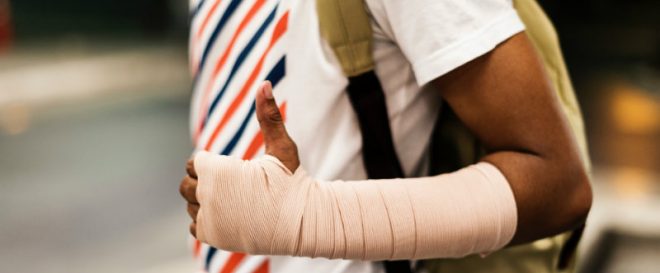Natural Injury Recovery: Fast Action Pain Relief and Accelerated Healing

Here’s the truth—in any physically demanding pursuit, you have a chance of getting injured. This is a reality that comes with working out, playing a sport, or generally, having an active lifestyle.
This is why you should know what to do when faced with an injury. Whether it’s a minor sprain, a fracture, or a torn ligament, you wouldn’t appreciate the pain and limited mobility that comes with it.
How well you recover from injury would depend on how well you handle it.
How Your Body Recovers from Injury
Before we get to the ways of managing the injury, you must first have a good understanding of what happens during recovery. Simply put, the entire process has three main phases:
Inflammatory Phase
This phase immediately starts after your body experiences physical trauma. You would experience swelling, pain, limited mobility, and intense tenderness around the injured tissue. These symptoms can last for the first 24 to 72 hours following an injury.
The symptoms arise due to increased blood flow and inflammation—processes that actually allow the body to get rid of damaged tissues. In cases where blood vessel are damaged, nearby blood vessels are remodelled for the sake of maintaining blood flow in the area.
You can gently move the injured part to further promote blood flow. This will also help in reducing the pain and swelling. You can use painkillers but only those that do not eliminate inflammation.
Proliferative Phase
In this phase, which may take up to eight weeks, tissues damaged from the injury start to be rebuilt. There’s a noticeable decrease in swelling, tenderness, and pain around the area.
The body builds or forms the structure of the damaged tissues. However, this doesn’t mean that normal function and mobility will immediately return. What’s initially formed is quite fragile, and so reinjuring the part is a big possibility.
In this phase, you should undergo physical therapy suitable for your injury. This will promote overall recovery and the return of normal mobility. You should limit the stress placed on the injured part. It can set your recovery back if it prematurely handles movements or tension it cannot handle.
Remodelling and Maturation Phase
The injured tissues regain their normal and healthy structure. These tissues and the connections between them get back the strength required to function normally. This can last for a few months up to a few years, depending on the severity of the injury.
Your focus during this phase is the rehabilitation of function and mobility for the damaged area. Most exercises would involve tension stretching and contraction in a gradual and manageable manner. These exercises are crucial to orient the tissues for the stress of its normal function.
You’ll likely feel that you’re back to full health, but tissues, especially joints and ligaments, take a long time to heal. This is why you have to keep up with any physical therapy required.
How to Manage Pain and Boost Recovery
Promote IGF-1 Production
Insulin-like Growth Factor 1, or IGF-1, is a hormone used by the body for regenerating damaged tissues. The body also uses it to regulate inflammation, as chronic inflammation often signifies low IGF-1 levels.
Increased levels of IGF-1 improve recovery of damaged muscles, ligaments, and skin. It can likewise improve the strength of tissues during the second phase of the healing process. This can even counteract the reduced healing that results from disuse and immobilization.
Protein
Having more servings of protein is among the best ways of raising your IGF-1 levels. Good sources of protein include red meat, seafood, dairy products, and soy.
Zinc
Zinc stimulates the production of Growth Hormone (GH), which in turn leads to the release of IGF-1. Dietary sources rich in zinc include poultry, red meat, oysters, dairy products, shellfish, legumes, and seeds. Sometimes maintaining the ideal diet can be pretty hard though, so the best idea is to combine healthy eating with some wisely selected powerful supplements![]() .
.
Capsaicin
Capsaicin is the compound responsible for the spicy flavor of chili peppers. It increases the release of a peptide known as CGRP. This peptide promotes the production and release of IGF-1.
Supplement with Cissus
Cissus Quadrangularis is a perennial plant native to Southeast Asia, India, Bangladesh, Sri Lanka, Arabia, and parts of Africa. It’s used in traditional medicine for healing injured soft tissues and broken bones.
The plant improves recovery from bone fractures by increasing osteopontin protein levels. This protein helps broken bones regain their function, especially during the remodelling phase.
Aside from that, Pure Cissus Quadrangularis Extract contains steroids and vitamins that promote early regeneration of injured bone tissues. These also induce early bone mineralization, which helps damaged bones regain their strength.
As for its other effects, it can reduce pain in cases of chronic joint inflammation and bone injury. Its analgesic effect is similar to that of acetylsalicylic acid and can last from two to four hours.
Diabetics should take care when using Cissus Quadrangularis . It can lower blood sugar and might interfere with medications for blood sugar control. It’s also not recommended for those going under the knife.
Likewise, it isn’t advisable to use this during the first phase of your recovery. It has anti-inflammatory effects that can slow down the elimination of damaged tissues, prolonging overall recovery.
Use Heat Therapy
You can do heat therapy with a hot cloth, heating pad, hot water bottle, therapeutic ultrasound, hydrocollator packs, or whirlpool baths. Heat therapy can relieve pain and promote healing of injured tissues through increased blood flow and production of heat shock proteins (HSPs).
The raised temperature boosts blood flow. This in turn increases the oxygen and nutrients supplied into the injured area. Although it can improve blood flow, using heat therapy during the inflammatory phase isn’t a good thing. Heat can potentially cause further damage on the injured tissues.
HSPs also help in the recovery of muscle protein after long periods of inactivity. This is essential in improving recovery from injuries like broken bones, injured soft tissues, and dislocated joints, all of which require limb immobilization.
When it comes to pain relief, heat therapy is also quite effective. But, it can only relieve pain from non-inflammatory causes. These include muscle spasms, pain from overexertion, muscle soreness, osteoarthritis, and fibromyalgia.
Do keep in mind though, that heat therapy should last at least 15 to 20 minutes for minor injuries and 30 minutes to 2 hours for major ones. The temperature must also stay below 43OC (110OF). Temperatures of more than 45OC (113OF) will cause pain and tissue damage.
Apply Topical Analgesics
Topical analgesics offer convenient relief from pain. It’s an option for those who prefer easy-to-use pain relievers that won’t cause substance dependence or tolerance. Effective topical analgesics contain menthol, camphor, or capsaicin.
Menthol
It activates the kappa opioid receptors found on your skin. When these receptors are activated, it causes pain relief from sprains and muscle cramps. It also provides a cooling sensation that helps in reducing inflammation.
Camphor
This substance numbs nerve endings. Interestingly, the method of application changes the effect of camphor. Vigorous application gives a warm sensation, while a gentler approach offers a cooling sensation.
Capsaicin
This spicy compound reduces the levels of “substance P” on the area of application. Simply put, substance P is responsible for the transmission of pain signals to the brain.
Some of these topical analgesics create a warming sensation, meaning they’re capable of triggering the release of HSPs. Because of this, it’s safe to say that topical analgesics aren’t just for pain relief.
Take Kratom
decreased sensation of pain and enhanced mood.
Unlike opioid medications, kratom leaves provide a milder opioid interaction. This makes it less likely for its alkaloids to create dependence, which makes it a safer alternative for a given amount of time.
Some studies are even looking into kratom as a means for weaning off individuals who have developed dependence or tolerance to narcotic medications.
Of course, this does not mean irresponsible use of kratom won’t have negative consequences. It’s for this reason that limiting doses to a minimum is important. Furthermore, if you’re planning to take kratom, it is best to do further research on its use, precautions, and any drug interactions.
The Path to Full Recovery
You’ve just learned about some great ways of naturally managing pain and improving recovery. Natural methods should always be considered before taking any medication. This way, you’re minimizing your risk of experiencing side effects and developing substance dependence.
If you combine these with proper rest and physical therapy, regaining your strength and fitness shouldn’t be a problem. While the time needed to fully recover still depends on the injury itself, at least you’re confident that you’re doing everything necessary to hasten the recovery process.



